Getting Around Oslo


The harbourfront tram car can be taken to Vigeland Sculpture Park.
There are four cruise piers in Oslo. Søndre Akershus pier is located beneath the ramparts of Akershus Fortress, and directly south is Vippentang pier. On the other side of the peninsula is Revierkai pier. All three are within walking distance of the city centre where the main attractions can be explored on foot.
The fourth pier is located on the other side of Oslo’s harbour, near the new Tjuvholmen waterfront development.
A hop-on/hop-off bus stops near the cruise terminals and can be taken around the city centre and to the museums on the Bygdøy Peninsula. Passenger ferries also provide transport from the harbourfront to Bygdøy.
There is a tourist information office on Akershusstranda beside the cruise terminal. The city’s main tourist information office is opposite City Hall.
A city card (sold at tourist information offices) provides unlimited travel on public transportation (boats, buses, trams, trains) and free or reduced admission to most museums (www.visitoslo.com). National museums are closed Mondays and have free entry on Sundays; other days the adult admission is 50 NOK.
Taxi stands are situated throughout the city and taxis can be hailed on the street, but the ride will be expensive. The meter starts at about NOK 50 and the per kilometre fare varies from 14 to 30 NOK. Drivers accept credit cards and a tip is not expected.

One of the many bike stations in Oslo.
Numerous bike stations are situated in the city centre and require an electronic smartcard to release a bike, which must be returned within three hours to any of the bike stations. (You can pick up another bike at the same or any other bike station.) Tourist smartcards can be rented for 24 hours at the Tourist Information Centre near City Hall for NOK 100 and must be returned to the same office.
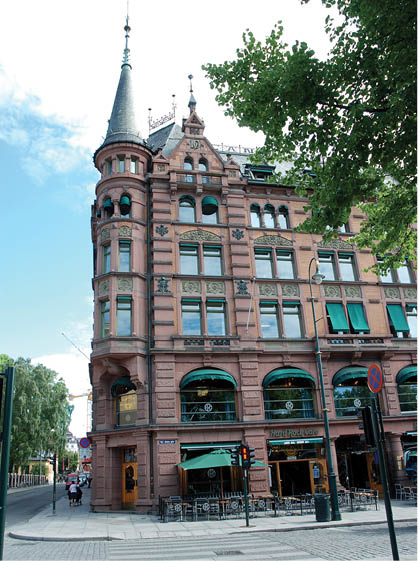
Hard Rock Cafe.
A variety of restaurants can be found on and around Karl Johans Gate, including a Hard Rock Cafe located between the Grand Hotel and the Royal Palace. Establishments steeped in tradition include the Grand Hotel’s street-level Grand Café, where Henrik Ibsen lunched every day (the proprietor would have a beer waiting at his table). Ibsen also had a regular table at Engebret Café on Bankplassen (Bank Square), as did Edvard Grieg and Edvard Munch. Another café popular with the city’s artists is Theatercaféen, located across the street from the National Theater. Waterfront restaurants and bars are concentrated in the revitalized dockside area of Aker Brygge and the adjoining new harbourfront at Tjurholmen.
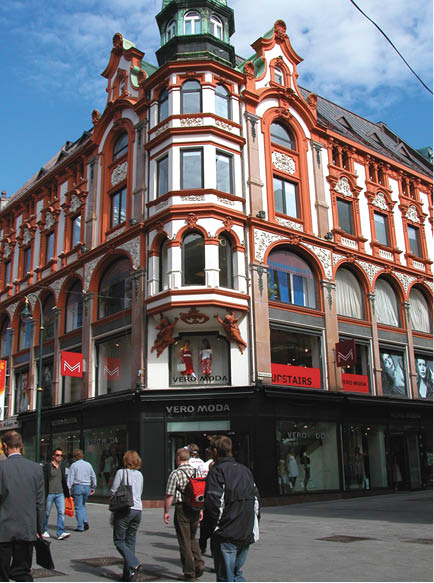
Shopping in Oslo.
Oslo’s main shopping area is the pedestrian precinct centred on Karl Johans Gate and its sidestreets. Here you will find chain stores and Norwegian clothing stores such as Vero Moda. Exclusive shops can be found along Akersgata.
An Oleana store, carrying a prize-winning collection of knitwear, silk scarves and silver jewellery, is located on Stortingsgata overlooking Spikersuppa. (Michelle Obama purchased several Oleana sweaters while visiting Oslo in December 2009.)
A Holm store carrying Norwegian souvenirs and sweaters by Dale of Norway is located next to City Hall. The House of Oslo department store on Ruseløkkveien (in between the Royal Palace and Nobel Peace Center) opened in 2006 and features Scandinavian-designed housewares in its 20 shops (including an Illums Bolighus).
Most museums have excellent gift shops selling high-quality souvenirs. A handful of shops selling quality sweaters and souvenirs is located inside the Akerhus cruise terminal.
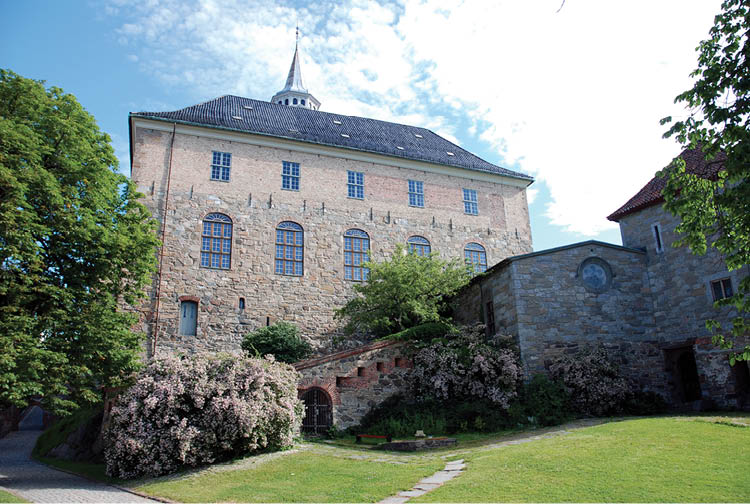
Akershus Fortress
1. Akershus Fortress & Castle – was first constructed in about 1300 and it was from here that Denmark’s Queen Margrethe ruled Norway. Damaged in the 1624 fire, Akershus Castle was remodelled as a Renaissance palace. The Norwegian fascist leader and Nazi collaborator Vidkun Quisling was imprisoned here at the end of World War II while awaiting execution as a traitor. Admission is charged to visit the castle’s chapel and Royal Mausoleum. The castle grounds also contain the Resistance Museum, which documents Norway’s resistance to the Nazi occupation of 1940-45. The fortress area is open free of charge, and in summer members of the King’s Guard gather daily in the fortress square to begin their daily parade to the Royal Palace via Kirkegata and Karl Johans Gate.
2. Museum of Contemporary Art – Kirkegata leads past Bankplassen (Bank Square) location of this museum.
3. National Museum of Architecture – administered by the National Museum. Engebret Café, Oslo’s oldest restaurant, is also located in this historic square.

Oslo’s modern Opera House
4. Opera House – To the east, along on the waterfront is Oslo’s Opera House, which opened in April 2008. Input from the public played a role in the architectural planning of its striking modernist design. Partially submerged, the building’s gently inclined roof resembles two tidewater glaciers converging and flowing seaward into the fjord. People are allowed to walk onto the roof, which has become a big draw for skateboarders attracted to its smooth marble slopes.
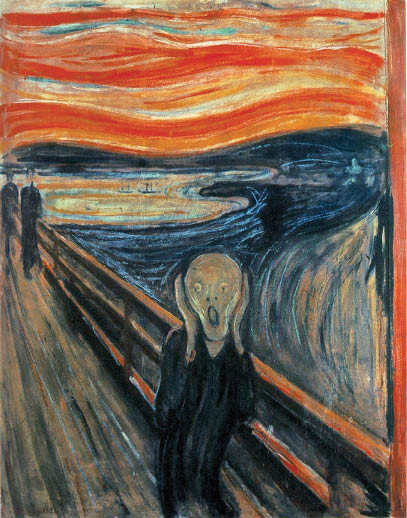
The Scream by Edvard Munch.
5. Munch Museum – Located a few kilometres northeast of the city centre, this museum houses a collection of paintings, drawings and prints the artist bequeathed to the city of Oslo upon his death in 1944 at the age of 80. Edvard Munch was a pioneer of expressionism and his paintings, initially considered brutal and disturbing, reflect his profoundly unhappy childhood. Born in 1863, Munch was raised in Oslo by his father after his mother died when Munch was five. A sickly boy, Munch later wrote that he “inherited the seeds of madness” from his father, who was morbidly pious and obsessed with the macabre. One of Munch’s sisters died in childhood (the subject of The Sick Child) and another became mentally ill. Stalked by death, Munch expressed his anguish in his art, his most famous work being The Scream, of which he created several versions – two paintings and two pastels. A painted version (and a pastel) is housed in the Munch Museum (the other is at the National Gallery). In August 2004, two masked gunmen entered the Munch Museum and stole Munch’s Scream and Madonna in a daylight heist. The paintings were eventually recovered. The fourth version (a pastel) of The Scream is privately owned and was auctioned for a record-settting $120 million at Sotheby’s in New York in 2012.
6. The Oslo Cathedral – built of red brick and inaugurated in 1697 as Church of Our Saviour, is located at Stortovet Square and is where public events such as royal weddings and funerals are held. In 2001, Crown Prince Haakon married Mette-Marit Hoiby at the cathedral, which contains its original pulpit and altar, and has stained glass windows by Emanuel Vigeland. The eastern end of the square is enclosed by a curved building called the Bazar, into which is integrated the tower of the Fire Watch (Oslo’s main fire station from 1860 to 1939).

Spikersuppa
7. The Storting – Oslo’s high street, Karl Johans Gate, leads from the Cathedral to the civic centre where notable buildings overlook several city blocks of fountains, lawns and flower beds, called Spikersuppa. At one end of Spikersuppa is the Storting (Grand Assembly) building, which was completed in 1866 and houses the Norwegian parliament.
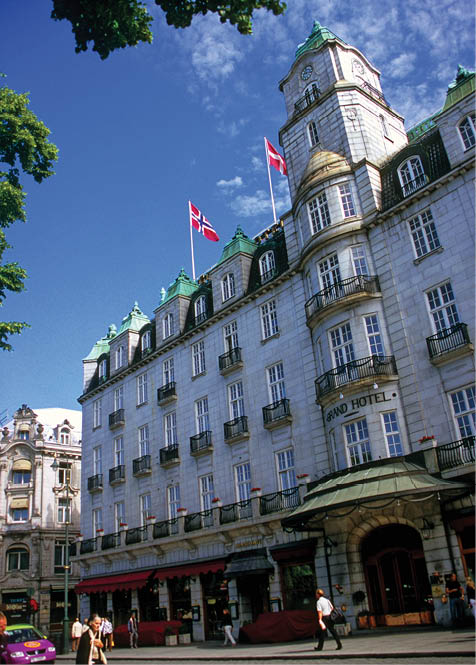
Grand Hotel
8. Grand Hotel – Across the street is this stately hotel, which opened in 1874 and which hosts the annual Nobel Peace Prize banquet, with the prize winner staying in the five-star hotel’s Nobel Suite. U.S. President Barack Obama, recipient of the 2009 Nobel Peace Prize, and his wife Michelle viewed the traditional torch light procession from the balcony.
9. Oslo University – Located near the western end of Karl Johans Gate, this University was founded in 1811.
10. National Gallery – Behind the university buildings, on Kristian Augusts Gate, is the National Gallery (part of the National Museum) which focuses on works by 19th- and 20th-century Norwegian artists, including a painted version of Munch’s The Scream.
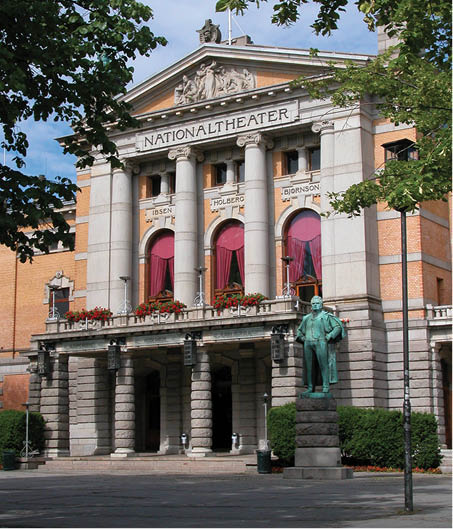
The National Theater
11. National Theater – across from the university, this building is one of Norway’s most revered cultural institutions and a showcase for the plays of Norway’s famous playwright Henrik Ibsen. Before becoming a major film star in the 1960s, Liv Ullmann performed regularly at this theatre in productions such as A Doll’s House.
12. Henrik Ibsen Museum – Located on Henrik Ibsens Gate, this is the restored apartment where the playwright spent the last 11 years of his life with his wife Suzannah, living modestly and writing his final two plays. Considered the father of dramatic realism, Ibsen left his native Norway in 1864 to escape its stifling conformity and write the controversial plays for which he is famous – A Doll’s House, Hedda Gabler and An Enemy of the People. When he returned 27 years later, the groundbreaking modernism he had introduced to western theatre had begun permeating all aspects of Norwegian life.
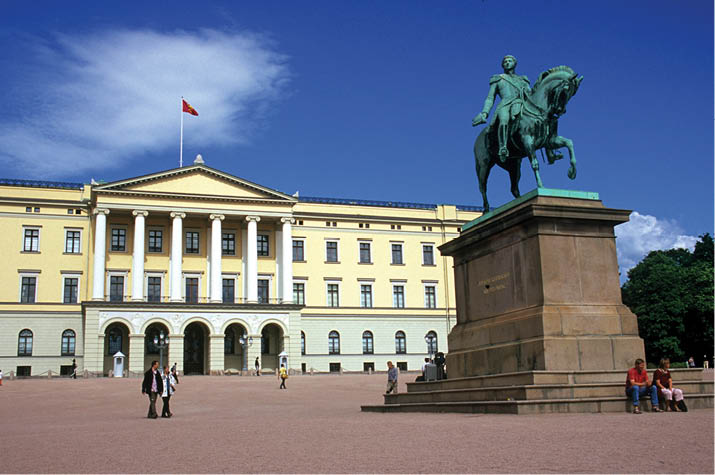
Royal Palace with statue of King Karl Johan in foreground.
13. Royal Palace – This building is situated on a sweeping rise at the end of Karl Johans Gate where a circular drive leads to the palace entrance. Designed by a Danish architect and completed in 1849 this neo-classical building was occupied only for short periods by visiting Swedish-Norwegian kings until Norway gained independence in 1905, at which time it became the permanent residence of the Norwegian monarch. Guided tours are available from mid-June to mid-August (some of which are in English) but tickets tend to sell out in advance. The park behind the palace, open to the public, is a peaceful setting of lawns and pathways leading down to an ornamental lake. In summer, the daily changing of the guard takes place in the palace forecourt at 1:30 p.m.

Vigeland Sculpture Park
14. Vigeland Sculpture Park – one of Norway’s best-known cultural attractions, located about a mile west of the Palace grounds. Occupying 80 acres within Frogner Park, the Vigeland Sculpture Park was conceived and created by Gustav Vigeland, who spent 40 years of his life planning and designing groups of nude sculptures that illustrate the development of man. Of the park’s many colossal sculptures, most impressive is the Monolith – a towering granite column of intertwined bodies. Vigeland was initially commissioned in 1907 to create a fountain for the city, and this became the starting point for the sculpture park. In 1921, Vigeland agreed to donate all of his works to the city in exchange for a custom-built studio and residence in which to complete his sculpture park. Today this building, adjacent to the park, is a museum containing the sculptor’s original works. Entry to Vigeland Sculpture Park is free and the grounds can reached by tram car from the harbourfront.
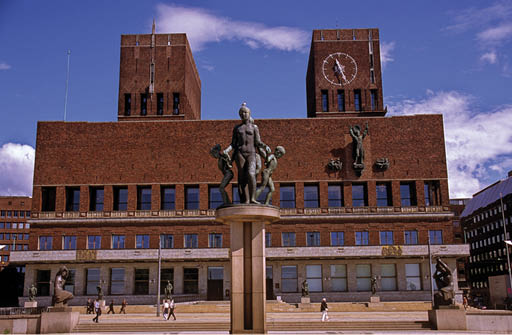
Oslo’s City Hall
15. City Hall – located on the harbourfront, was inaugurated in 1950. This brown-brick building emulates the traditional northern-European town hall with its two towers and large clock with a 49-bell carillon that plays every hour. The hall’s interior is decorated with works by Norwegian painters and sculptors, its massive main hall featuring colourful murals. The Nobel Peace Prize is awarded here each December, the ceremony attended by members of the Norwegian royal family.
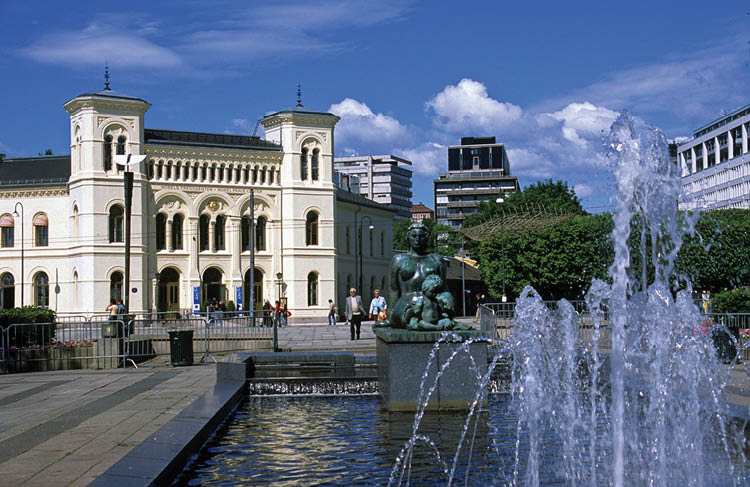
Nobel Peace Center
16. Nobel Peace Center – Close to City Hall, the Nobel Peace Center opened in 2005 and commemorates the life and vision of Alfred Nobel as well as the lives of various Nobel Laureates. Housed in a refurbished, 19th-century train station, the centre’s film, video and photo exhibits are presented with state-of-the-art technology and interactive installations. The Peace Prize is the only Nobel prize awarded outside of Sweden, and the recipient of this illustrious award is selected by a five-member committee elected by the Norwegian parliament.
Another harbourfront attraction is Aker Brygge – a former shipyard that’s been converted into a pedestrian area filled with shops and restaurants, as is the adjacent Tjuvholmen harbourfront where the new Museum of Modern Art (designed by Reno Piano) is a major attraction.
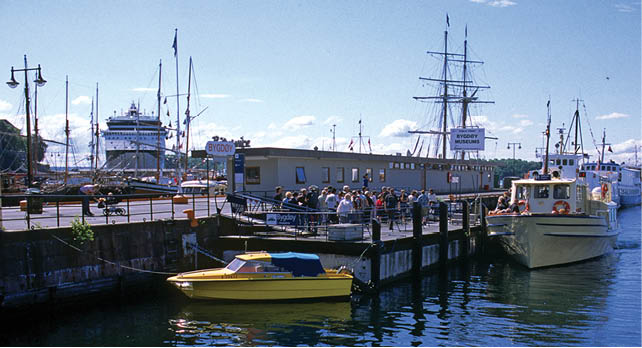
The passenger ferry to Bygdøy.
Passenger ferry boats dock at the head of Oslo’s harbour, including one that makes regular 10-minute crossings from Pier 3 to the Bygdøy Peninsula where five museums are located, including the Fram Museum, Kon-Tiki Museum and Viking Ship Museum. The ferry stops at two docks, the first (Dronningen) is located a half-mile walk to the Viking Ship Museum and Norwegian Folk Museum; the second stop (Bygdøynes) is right beside the Fram, Kon-Tiki and Maritime museums. All five museums are open daily throughout the summer.

A Bygdøy residence.
17. Oscarshall – Bygdøy is an exclusive residential area with parks, beaches, a royal farm and a summer palace called Oscarshall, which was built in the Neo-Gothic style in the mid-19th century by Oscar I to showcase Norwegian artistry and craftsmanship. Resembling a small castle, Oscarshall sits on a rise overlooking the water and is surrounded by manicured parkland. Originally a private royal residence, in 1881 Oscar II opened the palace to the public.

Viking Ship Museum.
18. The Viking Ship Museum – This museum houses two of the best-preserved Viking ships ever found. Discovered in royal burial mounds, the ships date from the 9th century and were used to transport the remains of high-ranking chieftains on their final voyage to “the other side.” Jewellery, weapons and other artifacts found in their graves are also on display.
19. Norwegian Folk Museum – The open-air Norwegian Folk Museum contains reproductions of traditional houses and a 13th-century stave church, constructed entirely of wood. Hosts dressed in folk costumes provide assistance and demonstrate various activities.
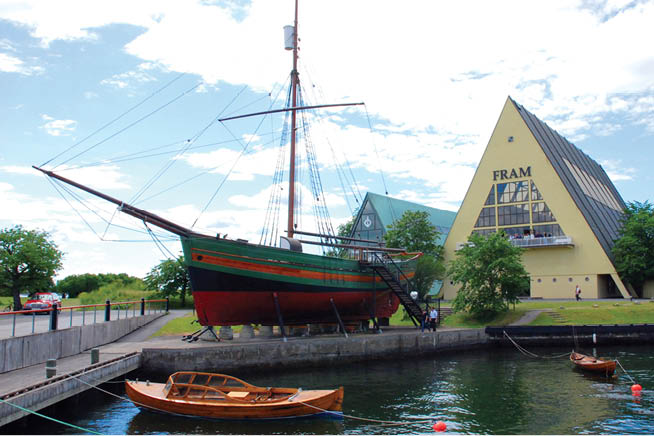
Fram Museum.
20. The Fram Museum – This museum, shaped like an inverted V, was specially constructed to preserve the wooden schooner Fram as a national monument. The brainchild of the Norwegian polar explorer Fridtjof Nansen, the ship was specially built to withstand the crushing pressure of pack ice as it drifted across the Arctic Ocean. The Fram was also used by Otto Sverdrup to explore the islands northwest of Greenland and, in 1910, Roald Amundsen sailed her to the Antarctic where he and four crewmembers made history by being the first to reach the South Pole.
21. Norwegian Maritime Museum – Amundsen’s other famous ship, the Gjøa, used to be displayed at the nearby Norwegian Maritime Museum, but in 2009 plans were set in motion to build extra exhibit space at the Fram Museum to better display and preserve this famous vessel – the first to sail through the Northwest Passage.

The famous Kon-Tiki raft
22. The Kon-Tiki Museum – A tribute to the Norwegian explorer and anthropologist Thor Heyerdahl who, with the help of five crewmen, built a wooden raft in 1947 and sailed it across the South Pacific Ocean from Peru to an island in the Tuamotos. The wooden raft, called Kon-Tiki, is on display as is Ra II (another papyrus raft built by Heyerdahl) and statues from Easter Island.
23. Holocaust Centre – About about a mile from Bygdøynes pier, housed in the former residence of the Nazi collaborator Vidkun Quisling, is the Holocaust Centre. Quisling was executed for treason in 1945 and his home, Villa Grande, now houses a permanent exhibition on the fate of Norwegian Jews during World War II (closed Mondays).
One of Oslo’s most popular out-of-town attractions is the Holmenkollen Ski Museum and Jump Tower. The museum traces 4,000 years of skiing history with exhibits that include ski equipment used by the famous polar explorers Nansen and Amundsen. The premises also feature a ski jump simulator, gift shop and café. The views are sweeping from atop the ski jump, originally built for the 1952 Winter Olympics but recently dismantled and a new one built for the 2011 Nordic World Championship. The Metro 1 bus travels to Holmenkollen.

A Hurtigruten ship pulls into one of Norway’s southern fjords.
Located near the southernmost tip of Norway, this harbour city has long been a popular summer destination for vacationing Norwegians. The waterfront boardwalk leads past parks, a public beach and a 17th-century fortress with exceptional sea views. The waterfront bustles with a busy fish market and café on every corner, and the visitor information centre provides maps of self-guided walks through the charming old town, founded by King Christian IV in 1641.
A bridge connects Kristiansand with the island of Odderoya, a former naval base where remaining ramparts and 18th-century buildings can be explored. Other tours include a boat trip to the pretty village of Lillesand, and a visit to Setesdal Mineral Park, its amazing collection of minerals and crystals housed in caverns within a mountain.

Not until the late 1800s, when the Norwegian government undertook an extensive nautical survey of its long and intricate coastline, were the remote fjords and coastal communities of western and northern Norway connected by regular steamship service to the southern part of the country. The initial steamship service – transporting passengers, cargo and mail – expanded over time to connect more and more harbours. This nautical lifeline became known as Hurtigruten (“the express route”) because it was much faster than travelling overland. In the 1980s, Hurtigruten (then called Norwegian Coastal Voyage) began launching larger and more luxurious ships to appeal to the growing tourist market. Today, Hurtigruten’s fleet offers year-round cruises out of Bergen, while the major cruise lines offer summertime sailings to the fjords of Norway.
The Norwegian climate is ideal for summer cruising, with the days lengthening the farther north your ship travels, and the warm ocean currents providing coastal towns with relatively warm weather at these northern latitudes. Green valleys lying at the head of glassy fjords where villages cluster around country churches and farmhouses cling to mountainsides.

Norway offers breathtaking scenery in the fjords between Stavanger and Bergen including this hike to the rock ledge at Trolltunga.
Called the Shortcut to the Norwegian Fjords, the Stavangar region occupies the southwestern corner of Norway and is where the Viking king Harald the Fairhair built his first royal residence after uniting Norway into one kingdom in 872 AD. Three swords set into the mountain rock above Hafrsfjord Bay serve as a memorial to King Harald I.
The shipbuilding and fish processing port of Stavanger is situated at the mouth of Stavanger Fjord, one of many arms of the extensive Boknafjorden. The cruise ships dock in the city centre, a short walk to Old Stavanger’s narrow, cobbled lanes lined with white wooden buildings built two centuries ago and now housing craft shops, galleries and museums. Local attractions include the Fish Market and the town’s 12th-century Cathedral of St. Swithin, built of stone in the Anglo-Norman style, is a scaled-down replica of Winchester Cathedral in England.
Excursions offered in Stavangar include city walking and sightseeing tours, with visits to the Norwegian Canning Museum and the Norwegian Petroleum Museum (North Sea oil is refined here, earning Stavanger the title of Petroleum Capital of Norway). An eight-hour driving tour can be taken into the mountainous area of Gloppedalen to view Europe’s largest boulder scree, while a shorter, four-hour trip can be made to Norway’s only preserved medieval abbey (Utstein Abbey) which was a royal estate of Viking kings. Helicopter tours provide breathtaking aerial views of the Stavanger region.
Boat tours include one to Avaldsnes Karmøy, site of King Harald’s first royal residence, to visit the Long House of Bukkøy.
An hour’s boat trip from Stavanger is Lysefjord, where Pulpit Rock, a heartstopping clifftop plateau, looms 2,000 feet above the deep blue water of the fjord. Even higher, at 3,000 feet, is Kjeraag cliff. It was from this precipitous perch that a 32-year-old daredevil named Thor Axel Kappfjell, who had successfully parachuted from some of the world’s tallest buildings, attempted his last illegal leap in July 1999. He likely lost his bearings in the night fog and crashed into the cliff face while descending, for his body was found at the base, his parachute open.

Traditional Norwegian dress with Hardanger embroidery.
Hardangerfjord, the second largest fjord in Norway, winds for 114 miles (183 km) inland before branching into several smaller fjords, including 15-mile-long (24 km) Eidfjord. The scenic valleys and cascading waterfalls of the Hardanger region make it a favoured tourist area, once known mostly for its Hardanger fiddle (similar to a violin and considered the national instrument of Norway) and its famous Hardanger embroidery (Hardangersøm). This craft flourished from 1650 to 1850 and became the classic ornamentation of the bunad – a traditional Norwegian costume consisting of a long apron worn over a white blouse and a full skirt .
Some cruise ships visit the village of Ulvik, a tender port hidden at the head of Hardangerfjord where passengers are tendered ashore to tour the scenic valleys and fruit orchards. The major port in this area is Eidfjord, from which excursions can be taken to view such scenic wonders as Hardangerjøkulen Glacier and Vøringsfossen – Norway’s most famous waterfall with its free fall of 535 feet. Kjeasen, nestled on a mountain ledge above Simafjord, is touted as “the most inaccessible mountain farm in Norway” and offers a spectacular view of Eidfjord.
Eidfjord is also the gateway to Hardangervidda, which is the largest high-mountain plateau in Europe and Norway’s largest national park. Hardangervidda Nature Centre, located five miles (8 km) from the cruise port, is a modern facility housing interactive exhibits about the natural and cultural heritage of the area, with a cafe and gift shop on the premises. Other manmade attractions include Sysendamman (one of Norway’s biggest stone-filled dams) and Sima Power Plant, built right into a mountain.
The Troll Train takes visitors on a one-hour sightseeing tour along the shores of the fjord, with a stop at a Viking burial ground and medieval stone church. An outdoor activity centre provides bike/canoe rental as well as paddling instruction for beginners.

Bergen’s Hanseatic waterfront
Surrounded by the timeless grandeur of mountains and fjords, Bergen is known as the Gateway to the Fjords of Norway. The second-largest city in Norway, with a population of a quarter million, Bergen has managed to retain a village feel along its harbour. It was once the largest city of medieval Norway and a member of the Hanseatic League, its wealthy merchants imposing their unpopular rule from the mid-1300s to mid-1500s. Many of Bergen’s churches and monasteries were destroyed during social upheavals of the Reformation, but it retained its role as Norway’s leading city until the rise of Oslo in the 19th century.
The ships dock either at Skoltegrunnskaien Pier (which is a short walk to the historic harbour) or at a pier further away (in which case, a ship’s shuttle is provided). Bergen is very walkable, while brightly painted open trains on wheels and hop-on hop-off buses offer tours of the city.
The old Hanseatic Quarter of wooden warehouses and narrow, winding streets (called Bryggen) has been declared a World Heritage Site. The old Hanseatic wharf consists of a colourful row of quayside warehouses, rebuilt in their medieval gabled style after a fire in 1702. Today they house shops, art studios and restaurants. Of historic note are the Hanseatic Museum, the 12th-century St. Mary’s Church and the 13th-century Bergenhus fortress containing Haakon’s Hall (built when Bergen was the political centre of Norway and rebuilt following damage sustained during WWII). In the 1560s, the governor of Bergenhus built himself Rosenkrantz Tower, which served as a residence and fortified tower.
The bustling Bergen Fish Market is at the far end of the harbour, about a five-minute walk from Bryggen, and nearby is the Ulriken cable car ride up Mount Ulriken, highest of the seven mountains surrounding Bergen. The Bergen Aquarium is at the harbour entrance, and the modern Bryggens Museum is a third of a mile (.5 km) from Skoltegrunnskaien Pier. Bergen’s art galleries are clustered around a small, centrally located lake and admission is free with the purchase of a Bergen Card.
Bergen has long been a cultural centre, attracting the best of Norway’s musical talent. Edvard Grieg was born in Bergen in 1843 and his former residence, located in the suburbs of Bergen, is a museum.
The Fløibanen Funicular (also free with a Bergen Card) is located in the centre of town. It’s a six-minute ride to the 1,000-foot summit of Mount Floyen, where visitors can enjoy splendid views of the city and hiking paths.
Shore excursions in Bergen include a visit to Edvard Grieg’s home, called Troldhaugen, which was built in 1885 and is now a museum. The lakeside property also contains the studio in which Grieg composed much of his music and a modern concert hall where chamber music is performed. Another notable attraction on a driving tour is the Fantoft Stave Church, first built in 1150 and rebuilt following a 1992 fire.
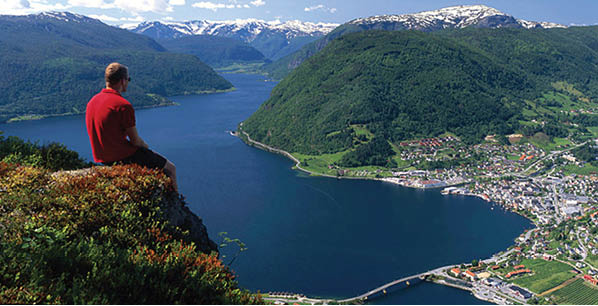
A mountaintop view of Flam.
The village of Flam lies at the head of Aurlandsfjorden, and the village of Skjolden lies at the head of Lustrafjorden, two of the innermost arms of Sognefjord – Norway’s longest and deepest fjord at 110 miles and depths exceeding 4,000 feet. Sognefjord branches into the Jotunheimen Mountains (Norway’s tallest) where Jostedalsbreen Glacier is the largest on the European mainland. In some places the mountainsides plunge a sheer 900 feet into the water on both sides of the fjord. Naerøyforden branches off Aurlandsfjorden and is listed on UNESCO’s World Heritage List for its exceptional beauty and wilderness.
The most famous attraction at Flam is the spectacular, 12-mile train ride that takes visitors on a journey through some of the wildest and most magnificent scenery Norway has to offer as it winds from the narrow Flamsdalen Valley up to a high, snow-covered mountain plateau. The steep climb along this standard-gauge railway – past cascading waterfalls, through spiralling tunnels and across narrow gorges – is made in locomotives powered by hydroelectricity.
Other shore excursions in Flam include kayaking or boat rides to explore the fjord landscape and perhaps spot some seals or dolphins. Hiking maps are available in the cruise terminal building, outlining walks that range from 30 minutes to three hours. Driving tours visit nearby villages and provide dramatic views overlooking the fjords where idyllic farms cling to the steep mountainsides. Along the mountain road between Aurland and Laerdal is a viewing platform called Stegastein, which overlooks Aurlandsforden from a height of 2,000 feet.
Shore excursions in Skjolden include coach tours to Jotunheimen National Park along the spectacular Sognefjell Mountain Road, and to Urnes Stave Church, Norway’s oldest stave church and a UNESCO World Heritage Site. Skjolden is the world’s first port to use the Norwegian-invented SeaWalk (a temporary floating pier structure that connects from ship to shore and replaces tendering).
The picturesque town of Olden lies at the inner end of Nordfjord, nestled in a beautiful valley at the base of glacier-clad mountains. The village centre is a ten-minute walk from the cruise pier where Old Church, built in 1759, stands on the site of a 14th-century stave church. On the other side of Olden is the Singer Home, where the American painter William Singer lived with his wife Anna from the early 1900s until his death in 1945. After inheriting a fortune from his family’s steel company in Pittsburgh, Singer and his wife travelled to Paris and the Netherlands in search of artistic inspiration, which the post-impressionist painter finally found in the solitude and serenity of the Norwegian fjords. The region’s snowcapped mountains and sunlit meadows became his muse, and the Singers became generous benefactors to the local community.
Local tour operators in Olden focus on the outdoors with rafting tours of Nordfjord and hiking to Mt. Huaren. Ship-organized excursions include boat trips on scenic Lake Olden and Lake Loen, as well as several tours to various arms of massive Jostedals Glacier, which covers approximately 300 square miles (777 square km). One glacier excursion features trail hiking to the face of Briksdal Glacier while another is a coach tour that ascends the Stryn Mountains to Lake Stryn to visit Justedal National Park Centre, a botanical garden and a geological park. Another coach tour, this one to Boyabreen Glacier, entails travelling through a four-mile-long (6 km) tunnel built in 1986 under Jostedals Glacier to reach the town of Fjaerland and the nearby Norwegian Glacier Centre.

Alesund is a pretty port filled with art nouveau architecture.
A major fishing port situated on three islands at the mouth of Storfjorden, Alesund is considered one of Norway’s prettiest towns with its art nouveau architecture of turrets and towers which lend the town a fairytale atmosphere. The town was rebuilt in this style following a devastating fire that struck one winter’s night in 1904. The cruise ships dock in the centre of town, where a hop-on hop-off offers local tours.
Out-of-town attractions include an open-air museum, 2.5 miles (4 km) east of town, which displays buildings from the Middle Ages. A nearby stone church dates from the early 13th century.
One excursion features a boat ride to the island of Langevag where the Devold factory once produced woolen sweaters, hats and mittens used by the polar explorers Nansen and Amundsen. The original factory, which opened in 1853, is now a museum but the factory outlet still sells traditional Norwegian sweaters and woolen blankets. Another excursion features a visit to the Saga Islands, birthplace of the Viking chieftain Rollo (who founded Normandy in 911) along with a stop at Atlantic Sea Park (the largest aquarium in Norway).
Included in most bus tours is Mt. Aksla Viewpoint – providing breathtaking views of Alesund and the surrounding islands, fjords and mountains. Mt. Aksla hiking excursions are also available.
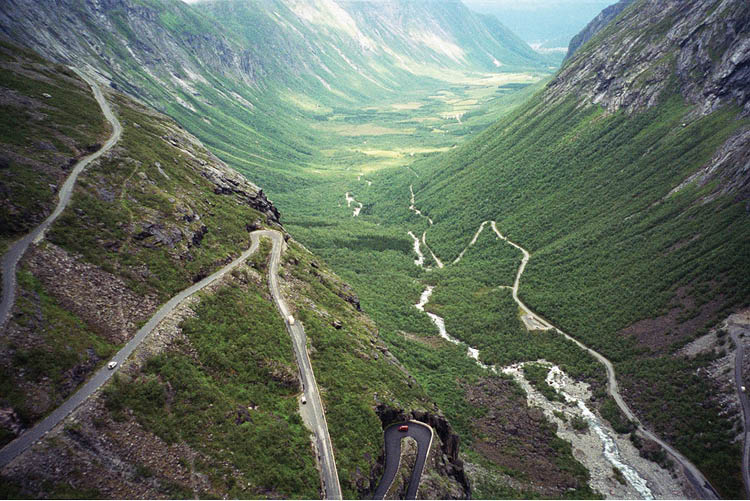
Troll’s Ladder.
One of the region’s most famous attractions is Trollstigroad (Path of the Trolls), which has been voted Norway’s most scenic drive. Also called Trollstigen (Troll’s Ladder), this road – cut into the mountainside and flanked by stone walls, ascends 2,815 feet above sea level and has 11 hairpin bends. A drive to Trollstigroad from the Alesund cruise dock includes a stop at Gudbrand’s Gorge – 80 feet straight down to the foaming river. Another stop is Trollstigen View Point before descending along the Path of the Trolls, past needle-sharp mountain peaks, to Andalsnes on the shores of Romsdalsfjorden. Highlights of the drive include crossing the 585-foot-high Stigfoss Waterfall and passing the Troll Wall – the highest vertical mountain wall in Europe at over 3,000 feet.
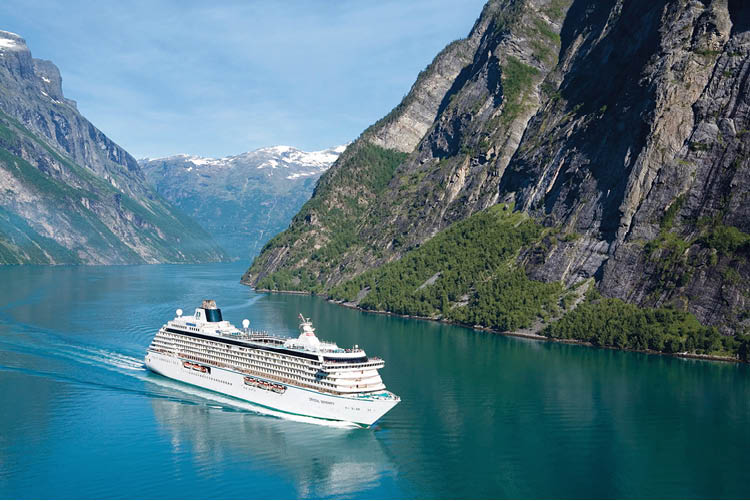
Crystal Symphony heading up Geiranger Fjord.
Of all the beautiful fjords in Norway, the fairest of them all is Geiranger. Lying at the very head of Storfjorden, the sublime Geirangerfjord is a UNESCO World Heritage Site and has been rated as the best cared for by National Geographic. The fjord’s pristine beauty is punctuated by abandoned farms perched on clifftop plateaus, one of which is reached by climbing a rope ladder.
Cruise ships anchor at the head of Geirangerfjord and passengers walk ashore along a temporary floating pier structure connecting the ship to the tender dock in the resort village of Geiranger. From here motorcoaches take visitors on tours into the mountains where the roads wind past lakes and waterfalls. Several viewpoints provide spectacular views of the fjord, including one at 4,500 feet (1372 m) from which the ship looks like a toy in the fjord below.
Shore excursions often include a visit to the Fjord Centre art facility which opened in 2002 and illustrates the extreme living and working conditions fjord farmers faced over the centuries. One excursion features a visit to a mountain farm where goats are raised for making cheese. Hiking to a waterfall or kayaking in Geirangerfjord are also offered.

Romsdalsfjord leads to the scenic town of Molde.
The charming fjord town of Molde is noted for its panoramic view of 222 mountain peaks. It’s also known for its proximity to the scenic Atlantic Road, completed in 1989 and voted as Norwegian Construction of the Century. Touted as the world’s most beautiful road trip, the Atlantic Road’s many bridges connect the islands and skerries (rocky islets) lying at the mouth of the area’s fjords.
Molde is situated on Romsdalsfjord, as is the smaller port of Andalsnes, located near the word-famous Trollstigroad – Path of the Trolls. The cruise ships dock in the town centres of both ports, from which shore excursions can be made to the area’s scenic highlights. In addition to the Atlantic Road and Path of the Trolls, other places of interest are the Mount Varden viewpoint for panoramic views and the fishing village of Bud. The Ergan Fortification – a WWII fort overlooking the Bjornsund Islands – is now a museum with an underground network of bunkers, headquarters and soldier’s quarters.
One coach tour includes a boat trip – in a replica Viking ship – from Geitoya Island to the fishing community of Haholmen, which is the island home of adventurer Ragnar Thorseth, who builds and sails Viking ships around the world. Other excursions include hiking Mount Varden, or visiting an open-air museum with folk dancing demonstrations.

Trondheim’s famous cathedral
The first capital of Norway, Trondheim was founded by Olaf I in 997 on a peninsula in Trondheimsfjord. Its original name was Nidaros and it became an important Christian centre and place of pilgrimage with construction of a cathedral over the tomb of St. Olaf (King Olaf II). Considered the finest Gothic cathedral in Scandinavia, its design was overseen by the Archbishop of Nidaros who, after visiting Canterbury Cathedral in England, ordered his architects to incorporate several of its design features. (The cathedral was rebuilt in 1869, after several fires, using Norwegian blue soapstone and white marble.)
The Reformation diminished the importance of Nidaros as a religious centre, and the city was renamed Trondheim in 1537. Eventually eclipsed by the trading port of Bergen, Trondheim regained some of its former prominence when the first king of a modern, independent Norway was crowned in Trondheim Cathedral in 1906. All coronations since have taken place in Trondheim Cathedral, and the crown jewels are kept here. Another building of note in Trondheim is the royal residence of Stiftsgaard, built in the late 1700s and used by Norway’s king and queen when they visit Trondheim.
Local museums include the Archbishop’s Palace, built in the 12th century, which houses original sculptures from Nidaros Cathedral and national regalia in the palace’s medieval vault. The National Museum of Decorative Arts features Norwegian craftsmanship through the centuries, and Trondheim Art Museum contains Norway’s third-largest art collection with an emphasis on Norwegian art. The open-air Folk Museum features wooden buildings (including a 12th-century stave church) situated around the ruins of a medieval castle. Kristiansten Fort, built after the great city fire of 1681, repelled a Swedish conquest in 1718 but was overtaken by German forces during WWII and used for executing members of the Norwegian Resistance. The fort provides a sweeping view over Trondheim.
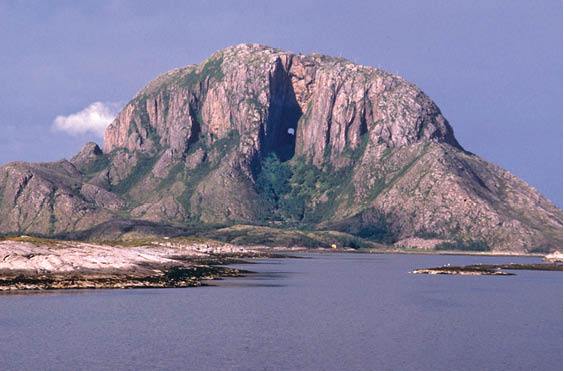
Erosion from ice and water formed the hole in Torghatten on Torget Island, although legend says the hole was created by the arrow of a troll.
Norway’s northern region, which straddles the Arctic Circle, is the land of the midnight sun and the reindeer-herding Sami.

North of Torghatten is the Arctic Circle Monument, which marks that famous line of latitude.
Tromsø, situated on the island of Tromsøy at latitude 69º, lies above the Arctic Circle and is the largest city in northern Norway with a population of 65,000. The Sami were the area’s earliest inhabitants, followed by the Vikings. By the end of the 19th century, Tromsø was an important trading centre and base for Arctic expeditions, with explorers such as Nansen and Amundsen often recruiting crew here. Today the port of Tromsø is a base for shipping, herring fishing and seal hunting. In summer the sun doesn’t set between May 21 and July 21. In winter, when darkness descends, the northern lights are a common sight in the skies over Tromsø.

Tromsø.
A university town, Tromsø is home to both historic and modern attractions, including its wooden cathedral (built in 1861), the Polar Museum (housed in an 1830s wharf building) and the Tromsø Museum (established in 1872 and now part of the University in Tromsø). Mack Brewery is where you can have a pint at the northernmost brewery in the world. Polaria is a modern adventure centre featuring panoramic films and an aquarium with Arctic sea mammals. Tromsø’s best-known landmark is the modernist Arctic Cathedral, symbolizing the strength of pack ice. Constructed in 1965, this iconic building stands on the mainland looking across the water to the city centre, which is connected by bridges.
Other attractions are the cable car ride up Mount Storsteinen for breathtaking views of the Troms Valley and surrounding mountains, and a visit to the Tromsø Wilderness Centre where visitors can experience Sami culture, including activities in traditional tents and dog sledging across a glacier with a team of Alaskan huskies. The fishing village of Sommarøy is 38 miles (60 km) west of Tromsø. A one-hour drive from Tromsø is the world’s northernmost 18-hole golf course – open 24 hours a day in summer.
Alta lies at the head of Alta Fjord, its forested setting a contrast to the region’s generally desolate landscapes. Cruise passengers are tendered ashore at Alta, where local rock carvings dating to c. 4200 BC are listed on UNESCO’s World Heritage List. The Alta River has carved Norway’s largest canyon and made headlines in the fall of 1979 when the local Sami and environmentalists protested the construction of a dam and hydroelectric power plant that would create an artificial lake and inundate a Sami village. Construction of the power plant went ahead, but was scaled down to cause less flooding of Sami land and less disruption to reindeer migration and wild salmon stocks.
North Cape, Europe’s northernmost point, is marked by a dramatic cliff that rises 1,000 feet (305 m) above the ocean. The sun doesn’t set here in summer (from the second week in May until the last week in July) and doesn’t rise in the middle of winter, when the only respite from darkness are the northern lights that shimmer across the sky. Honningsvag is the port at North Cape and it bustles with cruise ships at the height of summer while free-roaming reindeer graze on the tundra at the outskirts of town.
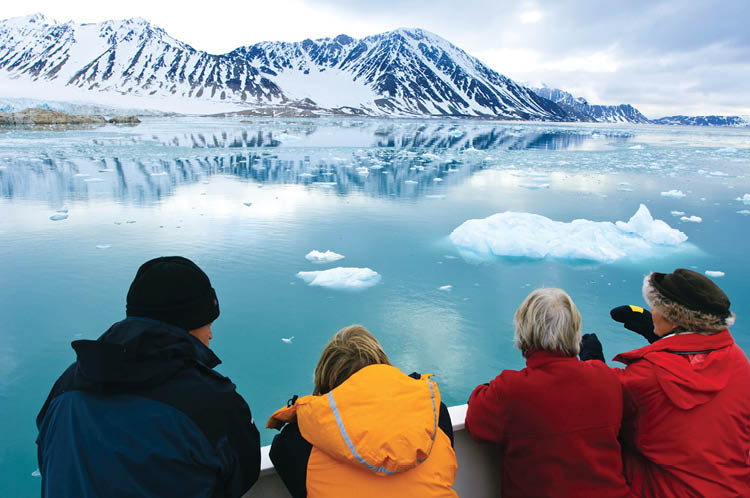
Cruising around Spitsbergen
Beyond North Cape is Spitsbergen – the largest island of the Svalbard archipelago, which lies halfway between mainland Norway and the North Pole. Excursions from the port of Longyearbyen, the world’s northernmost town, include hiking to a mountain plateau and a boat trip to view nesting seabirds.